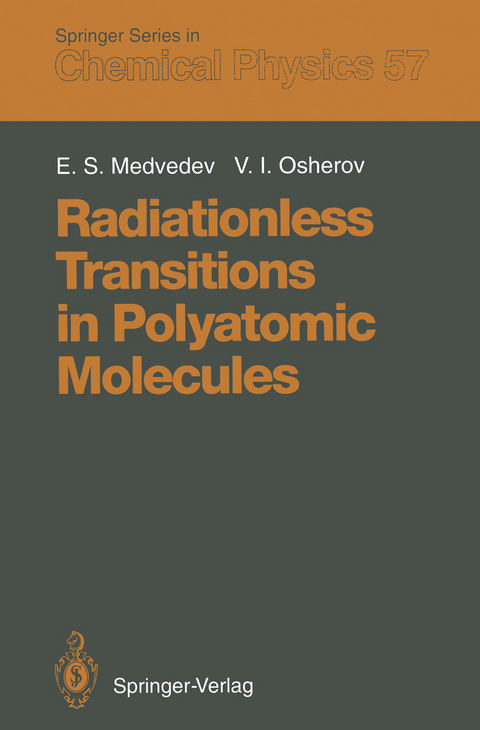
Radiationless Transitions in Polyatomic Molecules
Springer Berlin (Verlag)
978-3-642-85111-7 (ISBN)
The theory developed in this monograph as an introduction to the dynamics of electronically excited states and radiationless processes in polyatomic molecules for experimentalists, and theorists not intimately familiar with the field. For the expert it contains efficient methods to calculate transition probabilities, new applications of quasiclassical methods and fresh treatments of standard problems.
1. Introduction.- 2. Qualitative Theory of Radiationless Transitions.- 2.1 Balance Equation.- 2.2 Experimental Observations and Empirical Rules.- 2.3 Molecular Energy Level Model.- 2.4 Physical Nature of Radiationless Transitions.- 2.5 General Description of Luminescence Kinetics: Intermediate Case and Statistical Limit.- 2.6 Strong-Coupling Limit.- 2.7 Weak-Coupling Limit.- 2.8 Time-Dependent Perturbation Theory.- 2.9 Comparison of Various Expressions for the Transition Rate.- 2.10 Characterization of the Final States of an Isolated Molecule.- 2.11 Small, Large and Intermediate Molecules.- 3. Luminescence Intensity as a Function of Time and the Radiationless Transition Rate.- 3.1 Formulation of the Problem.- 3.2 Laplace Transformation, Green's Functions and Resonant States.- 3.3 Computation of the Green's Functions.- 3.4 Evolution of the Initial State and the Luminescence Intensity.- 3.5 Resonant States.- 3.6 Method of Projection Operators.- 4. Matrix Elements of Intramolecular Interactions.- 4.1 Adiabatic Approximation.- 4.2 Accuracy of the Adiabatic Approximation.- 4.3 Crude Adiabatic Approximation.- 4.4 Coupling Operators.- 4.5 Condon Approximation.- 4.6 Model of Noninteracting Oscillators.- 4.7 Mechanisms and Selection Rules for Radiationless Transitions.- 4.8 Overlap Integrals for Harmonic and Morse Oscillators.- 5. Quasiclassical Methods.- 5.1 Introductory Remarks.- 5.2 Overlap Integral for a Harmonic Oscillator.- 5.3 Overlap Integral for an Anharmonic Oscillator.- 5.4 Franck-Condon Principle for Radiationless Transitions.- 5.5 Transitions Between Parallel Terms.- 5.6 Overtone Vibrational Transitions.- 5.7 Collision Model.- 5.8 Two-State Vibronic Levels.- 6. The Statistical Limit.- 6.1 Accepting Modes, Effective States and the Transition Rate.- 6.2Generating-Function Method.- 6.3 Saddle-Point Method.- 6.4 Single Vibronic Level (SVL) Transition-Rate Dependence upon Initial Vibrational Energy.- 6.5 Transition Rate from Statistically Equilibrated Initial States.- 6.6 Summation of the Franck-Condon Factors.- 6.7 Inductive-Resonant-Transfer Mechanism.- 7. The Intermediate Case.- 7.1 Physical Effects.- 7.2 Correlation-Function Method.- 7.3 Kinetic Model.- 8. Conclusion.- Appendix. Commutation Rules for Angular Momentum in the Laboratory and Molecular Frame.- References.
| Erscheint lt. Verlag | 11.1.2012 |
|---|---|
| Reihe/Serie | Springer Series in Chemical Physics |
| Zusatzinfo | X, 374 p. |
| Verlagsort | Berlin |
| Sprache | englisch |
| Maße | 155 x 235 mm |
| Gewicht | 586 g |
| Themenwelt | Naturwissenschaften ► Physik / Astronomie ► Atom- / Kern- / Molekularphysik |
| Schlagworte | Excited-state dynamics • Molecular Spectra • polyatomic molecules • Radiationless transitions |
| ISBN-10 | 3-642-85111-8 / 3642851118 |
| ISBN-13 | 978-3-642-85111-7 / 9783642851117 |
| Zustand | Neuware |
| Haben Sie eine Frage zum Produkt? |
aus dem Bereich


